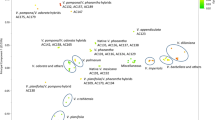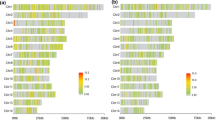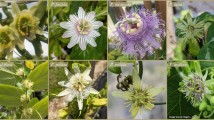Abstract
Vanilla planifolia is the primary botanical source of vanilla extract used globally in various foods and beverages. V. planifolia has a global distribution based on a few foundational clones and therefore has limited genetic diversity. Many Vanilla species easily hybridize with V. planifolia and could be a source of valuable genetic traits like increased vanillin content, disease resistance, or early flowering. While breeding Vanilla hybrids may improve plant performance, basic molecular tools for this species are lacking. DNA-based molecular markers are the most efficient method to validate hybrid progeny, detect hybrids in commercial plantings, and identify unknown accessions. This study used publicly available sequence data to develop species-specific, qRT-PCR-based molecular markers for Vanilla. Over 580,000 assembled sequence fragments were filtered for species specificity and twenty-two targets were selected for qRT-PCR screening. Ten targets differentially amplified among V. planifolia, V. pompona, V. phaeantha, and V. palmarum with ΔCT values as high as 17.58 between species. The ten targets were used to validate the parentage of hybrid progeny from controlled crosses with most hybrid progeny showing amplification patterns similar to both parents. The ten targets were also used to screen sixteen Vanilla species for specificity, and supported species assignments for unknown accessions including the detection of putative hybrids. This is the first report using species-specific, qRT-PCR-based molecular markers in Vanilla. These markers are inexpensive, simple to develop, and can rapidly screen large populations. These methods will enable the further development of species-specific molecular markers when creating Vanilla interspecific hybrid populations.






Similar content being viewed by others
References
Bruman H (1948) The culture history of Mexican vanilla. The Hispanic Am Hist Rev 28(3):360–376
Lubinsky P, Bory S, Hernandez J, Kim SC, Gomez-Pompa A (2008) Origins and dispersal of cultivated vanilla (Vanilla planifolia jacks. [Orchidaceae]). Econ Bot 62(2):127–138
Correll DS (1953) Vanilla - Its botany, history, cultivation and economic import. Econ Bot 7(4):291–358
Bouriquet G (1954) Le vanillier et la vanille dans le monde. Paul Lechevalier, Paris
Ecott T (2005) Vanilla: travels in search of the luscious substance. Penguin, London
Berenstein N (2016) Making a global sensation: vanilla flavor, synthetic chemistry, and the meanings of purity. Hist Sci 54(4):399–424. https://doi.org/10.1177/0073275316681802
Bory S, Grisoni M, Duval M-F, Besse P (2008) Biodiversity and preservation of vanilla: present state of knowledge. Genet Resour Crop Evol 55(4):551–571
Medina J, Jiménes G, and García H (2009) Vanilla: post-harvest operations. FAO. https://www.fao.org/fileadmin/user_upload/inpho/docs/Post_Harvest_Compendium_-_Vanilla.pdf. Accessed 1 January 2020
Chambers A (2018) Establishing vanilla production and a vanilla breeding program in the southern United States. In: Havkin-Frenkel D, Belanger F (eds) Handbook of vanilla science and technology, 2nd edn. Wiley, Singapore, pp 165–180
Bayman P (2018) The history of vanilla in Puerto Rico: diversity, rise, fall, and future prospects. In: Havkin-Frenkel D, Belanger F (eds) Handbook of vanilla science and technology, 2nd edn. Wiley, Singapore, pp 111–120
Gallage NJ, Møller BL (2018) Vanilla: the most popular flavour. In: Schwab W, Lange BM, Wust M (eds) Biotechnology of natural products. Springer, Berlin, pp 3–24
Soto Arenas MA (1999) Filogeografía y recursos genéticos de las vainillas de México. Instituto Chinoin AC Informe final SNIB-Conabio, proyecto J 101
Besse P, Da Silva D, Bory S, Grisoni M, Le Bellec F, Duval MF (2004) RAPD genetic diversity in cultivated vanilla: Vanilla planifolia, and relationships with V. tahitensis and V. pompona. Plant Sci 167(2):379–385. https://doi.org/10.1016/j.plantsci.2004.04.007
Childers NF (1948) Vanilla culture in Puerto Rico, vol 28. US Department of Agriculture, Washington, D.C.
Maruenda H, Vico MD, Householder JE, Janovec JP, Canari C, Naka A, Gonzalez AE (2013) Exploration of Vanilla pompona from the Peruvian Amazon as a potential source of vanilla essence: quantification of phenolics by HPLC-DAD. Food Chem 138(1):161–167. https://doi.org/10.1016/j.foodchem.2012.10.037
Dequaire J (1976) L'amélioration du vanillier à Madagascar. Journal d'Agriculture Traditionnelle et de Botanique Appliquée 23(23):139–158
Delassus M (1963) La lutte contre la fusariose du vanillier par les méthodes génétiques. L'Agronomie Tropicale Série 2, Agronomie Générale Etudes Techniques 18 (2):245–246
Flanagan NS, Chavarriaga P, Mosquera-Espinosa AT (2019) Conservation and sustainable use of vanilla crop wild relatives in Colombia. In: Havkin-Frenkel D, Belanger F (eds) Handbook of vanilla science and technology, 2nd edn. Wiley, Singapore, pp 85–110
Hu Y, Resende M, Bombarely A, Brym M, Bassil E, Chambers A (2019) Genomics-based diversity analysis of vanilla species using a Vanilla planifolia draft genome and genotyping-by-sequencing. Sci Rep 9(1):1–16
Simko I (2016) High-resolution DNA melting analysis in plant research. Trends Plant Sci 21(6):528–537. https://doi.org/10.1016/j.tplants.2016.01.004
Lamas A, Franco CM, Regal P, Miranda JM, Vázquez B, Cepeda A (2016) High-throughput platforms in real-time PCR and applications. Polymerase Chain Reaction for Biomedical Applications
Distefano G, Caruso M, La Malfa S, Gentile A, Wu SB (2012) High resolution melting analysis is a more sensitive and effective alternative to gel-based platforms in analysis of SSR: an example in citrus. PLoS ONE. https://doi.org/10.1371/journal.pone.0044202
Distefano G, La Malfa S, Gentile A, Wu SB (2013) EST-SNP genotyping of citrus species using high-resolution melting curve analysis. Tree Genet Genomes 9(5):1271–1281. https://doi.org/10.1007/s11295-013-0636-6
Wu SB, Wirthensohn M, Hunt P, Gibson J, Sedgley M (2008) High resolution melting analysis of almond SNPs derived from ESTs. Theor Appl Genet 118(1):1–14. https://doi.org/10.1007/s00122-008-0870-8
Gomes S, Breia R, Carvalho T, Carnide V, Martins-Lopes P (2018) Microsatellite high-resolution melting (SSR-HRM) to track olive genotypes: from field to olive oil. J Food Sci 83(10):2415–2423. https://doi.org/10.1111/1750-3841.14333
Elshire RJ, Glaubitz JC, Sun Q, Poland JA, Kawamoto K, Buckler ES, Mitchell SE (2011) A robust, simple genotyping-by-sequencing (GBS) approach for high diversity species. PLoS ONE. https://doi.org/10.1371/journal.pone.0019379
Melo ATO, Bartaula R, Hale I (2016) GBS-SNP-CROP: a reference-optional pipeline for SNP discovery and plant germplasm characterization using variable length, paired-end genotyping-by-sequencing data. BMC Bioinf 17(1):29
Melo ATO, Hale I (2019) Expanded functionality, increased accuracy, and enhanced speed in the de novo genotyping-by-sequencing pipeline GBS-SNP-CROP. Bioinformatics 35(10):1783–1785. https://doi.org/10.1093/bioinformatics/bty873
Qi P, Gimode D, Saha D, Schroder S, Chakraborty D, Wang XW, Dida MM, Malmberg RL, Devos KM (2018) UGbS-Flex, a novel bioinformatics pipeline for imputation-free SNP discovery in polyploids without a reference genome: finger millet as a case study. BMC Plant Biol. https://doi.org/10.1186/s12870-018-1316-3
Berthouly-Salazar C, Mariac C, Couderc M, Pouzadoux J, Floc'h JB, Vigouroux Y (2016) Genotyping-by-Sequencing SNP identification for crops without a reference genome: using transcriptome based mapping as an alternative strategy. Front Plant Sci. https://doi.org/10.3389/fpls.2016.00777
Kono TJY, Seth K, Poland JA, Morrell PL (2014) SNPMeta: SNP annotation and SNP metadata collection without a reference genome. Mol Ecol Resour 14(2):419–425. https://doi.org/10.1111/1755-0998.12183
Hapke A, Thiele D (2016) GIbPSs: a toolkit for fast and accurate analyses of genotyping-by-sequencing data without a reference genome. Mol Ecol Resour 16(4):979–990. https://doi.org/10.1111/1755-0998.12510
Soto Arenas MA, Dressler RL (2010) A revision of the Mexican and Central American species of Vanilla plumier ex Miller with a characterization of their ITS region of the nuclear ribosomal DNA. Lankesteriana Int J Orchidology 9(3):285–354
Wittwer CT (2009) High-resolution DNA melting analysis: advancements and limitations. Hum Mutat 30(6):857–859
Gundry CN, Dobrowolski SF, Martin YR, Robbins TC, Nay LM, Boyd N, Coyne T, Wall MD, Wittwer CT, Teng DHF (2008) Base-pair neutral homozygotes can be discriminated by calibrated high-resolution melting of small amplicons. Nucleic Acids Res 36(10):3401–3408. https://doi.org/10.1093/nar/gkn204
Kuhn D, Livingstone D III, Richards J, Manosalva P, Van den Berg N, Chambers A (2019) Application of genomic tools to avocado (Persea americana) breeding: SNP discovery for genotyping and germplasm characterization. Sci Hortic 246:1–11
Kuhn DN, Dillon N, Bally I, Groh A, Rahaman J, Warschefsky M, Freeman B, Innes D, Chambers AH (2019) Estimation of genetic diversity and relatedness in a mango germplasm collection using SNP markers and a simplified visual analysis method. Sci Hortic 252:156–168. https://doi.org/10.1016/j.scienta.2019.03.037
Menchaca R, Ramos J, Moreno D, Luna M, Mata M, Vázquez L, Lozano M (2011) In vitro germination of Vanilla planifolia and V. pompona hybrids. Revista Colombiana de Biotecnología 13(1):80–84
García RAM (2018) In vitro propagation of vanilla. In: Havkin-Frenkel D, Belanger F (eds) Handbook of vanilla science and technology, 2nd edn. Wiley, Singapore, pp 181–190
Merchant N, Lyons E, Goff S, Vaughn M, Ware D, Micklos D, Antin P (2016) The iPlant collaborative: cyberinfrastructure for enabling data to discovery for the life sciences. PLoS Biol 14(1):e1002342
Acknowledgements
This work was supported by a State Scholarship award from the China Scholarship Council to Dr. Juan Li; and by funds provided by the University of Florida Dean for Research to Dr. Alan Chambers. The authors also acknowledge Pamela Moon for her assistance with seed germination and Shelby Weber for her assistance with tissue culture of the hybrid populations.
Author information
Authors and Affiliations
Contributions
JL, LD, and AC generated the qRT-PCR data. MB maintained the tissue culture materials and performed the DNA extractions. AC designed the study, conducted the bioinformatics analysis, and wrote the first draft of the manuscript. All authors read and approved the final manuscript.
Corresponding author
Ethics declarations
Conflict of interest
The authors have no competing interests.
Additional information
Publisher's Note
Springer Nature remains neutral with regard to jurisdictional claims in published maps and institutional affiliations.
Electronic supplementary material
Below is the link to the electronic supplementary material.
11033_2020_5287_MOESM1_ESM.xlsx
Supplementary file 1 Supplementary Table S1 Trinity assembly fragment ID, fragment DNA sequence, fragment length, and the number of mapped reads for each publicly available vanilla accession with GBS data. (XLSX 22 kb)
Rights and permissions
About this article
Cite this article
Li, J., Demesyeux, L., Brym, M. et al. Development of species-specific molecular markers in Vanilla for seedling selection of hybrids. Mol Biol Rep 47, 1905–1920 (2020). https://doi.org/10.1007/s11033-020-05287-9
Received:
Accepted:
Published:
Issue Date:
DOI: https://doi.org/10.1007/s11033-020-05287-9




